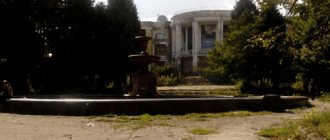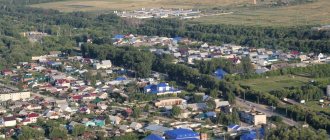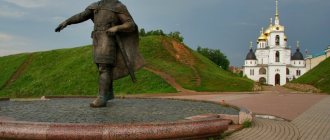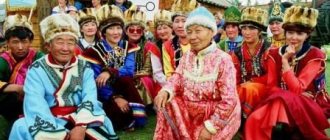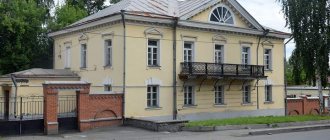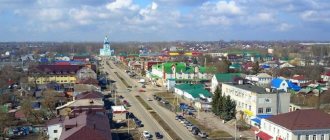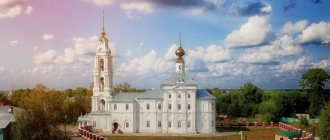Let’s start “walking” through the cities of our Tula region, and we’ll start with Kireevsk.
Why? I like this town, I have a special relationship with it, because in my time I often visited there, its streets awaken many pleasant memories in me. But this is all lyricism, but if it’s to the point, then... The town is small (according to the last census, about 20-odd thousand people were counted), 40 kilometers from Tula, quiet, sometimes it seems that it’s very quiet, although perhaps that’s me in such visited his corners more often. There are not many places for entertainment (but they exist, and, as they say, you can go, I have nothing to add here, because I have not visited any). More on this below, but now let’s look into the past.
Description
Kireevsk
on old maps of the 50s of the XX century, USSR
The village is located on the right bank of the Ob, 12 km north-northeast (via the Ob) from the regional center of Kozhevnikov, 81 km from Tomsk. From Tomsk you can get to Kireevsk by driving along the Shegarsky tract to the Shegarsky bridge, across the Ob, then turning south. A bus runs from the Tomsk bus station to Kireevsk twice a day, but not every day. Despite the fact that Kireevsk is located not far from Kozhevnikov directly, it is located on the other side of the Ob, so you have to get to the regional center by making a long detour through the neighboring regional center - the village of Melnikovo.
The population is about 430 inhabitants.
Streets
: Beregovaya, Karl Marx, Komsomolskaya, Krasnoarmeyskaya, Lenin, Lesnaya, Molodezhnaya, Embankment, Obskaya, Ozernaya, Equality, Siberian, Sovetskaya, Traktovaya.
Lanes
: Obskoy, Pionersky.
Postcode
:
636181
.[1]
Time zone: UTC +7, MSK +3, TSK +0
Story
The village has probably existed since the mid-19th century[2]. The basis of the settlement was the placement no earlier than 1840 here, on the banks of the Ob at the convict prison, of the state Kerevsky convict distillery
. Documentedly, the settlement near the plant was first included in the audit lists of populated areas of the Tomsk province in 1859[3].
From the biography of the Tomsk poet and writer P.A. Kazansky, who grew up in the village, as it was then called, Kerevsky / Kereevsky, in the 1870s, in addition to the Tsar’s distillery, there was a separate settlement police district
, which ensured general security, supervision of order in food and trade in wine and salt;
carrying out the movement (including convoy) of transported slaves and convicts; placement of displaced exiles, and control over them. There was a church in the name of St. Nicholas the Wonderworker
[4] (the rector was John Kosmin) and
a settlement almshouse
.
The main events of the Civil War bypassed the village. However, immediately after the establishment of Soviet power (January 1920), the peasants began to murmur against violence on the part of the co-procurers who carried out food appropriation. The archives preserve documentary evidence that on June 19, 1920, a “peasant uprising” arose in the village, to eliminate which (according to the GubChK VOKhR report) a detachment from the 327th battalion with one machine gun was sent
[5].
According to the 1926 census, Kireyevskoye had 373 households (farms), in which 1,765 people lived, including 841 men and 924 women with a completely predominant Russian population.
On May 27, 1905, a free public library was opened here, the first books for which, in the amount of 252 copies, were purchased with funds from the “Society for Promoting the Establishment of Free Libraries in the Tomsk Province,” created by P.I. Makushin and funds from the Tomsk Public Pavlenkov Fund [6].
In Soviet times, this right-bank Ob village, as well as the nearby villages of Astrakhantsevo and Kanaevo, were assigned to the jurisdiction of the Kozhevnikovsky village council (a village on the left bank of the Ob).
During these years, collective farms, a forestry, a timber plant, fishing artels, and a site for servicing buoys on the navigable riverbed were created and operated here. In the 1930s, the Kireevsk School of Peasant Youth (SHKM) was opened in a two-story house requisitioned from the repressed Kireev resident Konstantin Shevelev-Skripchenko. The “collective farm era” dates back to the creation of the rural promartel “Red Dawn” in Kireevsk in 1929, which united 5 small peasant partnerships. Its first chairman was Pyotr Arsentievich Pershukov. In 1930, the massification of the collective farm movement in the USSR led to the fact that more than half of the residents (and their families) of the village of Kireyevskoye ended up in the ranks of this artel. As a result, it was transformed into an industrial collective farm " The third decisive year of the Five-Year Plan
"
In the same year, the second Kireevsky industrial collective farm was formed - “ Red Spark
”, renamed in 1932 into the industrial collective farm “
15 Years of October
”. In 1941, both of these agricultural enterprises were merged into a single collective farm, “The Third Decisive Year of the Five-Year Plan,” whose chairman was M.V. Trampiltsev.
In parallel with the collective farms, the GULAG era was unfolding and the village became part of the network of special commandant’s offices of Siblag near the Ob, new waves of slaves came here “for logging.”
From the very beginning of the 20th century, the cultivation and production of tobacco was widely developed in the village - until 1922, tobacco growing was the only means of subsistence for the village residents.[7]. Also, the requirement of the Soviet government for collective farmers to grow tobacco in their gardens and hand it over for public procurement to the state remained until the mid-1970s.
The Great Patriotic War, which began in the summer of 1941, left its mark on the history of the village. In addition to the first mobilization of older men in June and July 1941, that summer was remembered for the action of deportation in August to the Siberian special commandant's offices of the repressed people of the Volga Germans, many of whom (including urgently demobilized and demobilized soldiers and commanders of the Red Army from among the Russian Germans) ended up at the timber enterprises of Kireevsk .
The main mobilizations of the majority of men and boys took place in 1942 and 1944. Not everyone who did returned returned to the village - they were often disabled after being wounded at the front.
Administrative and municipal status
Within the structure of administrative units, Kireyevsk serves as the administrative center of Kireyevsky District.[1] As an administrative division, it is part of the Kireevsky district as Kireevsk City of district jurisdiction
.[2] As a municipal entity, the city of Kireyevsk of district subordination, together with the Oktyabrsky rural district of the Kireyevsky district (which includes three rural areas), is part of the Kireyevsky municipal district as the
Kireyevsky urban settlement
.[6]
Attractions
- Memorial obelisk “To the fellow countrymen who fell during the war of 1941-1945” (opened in 1975).
- A monument of history and culture is the Kireevskaya Library, opened as a public library
back in 1905. - Resort and recreation area of the Tomsk region. Geographically, Kireevsk is located in the south of the Tomsk region. Wonderful, ecologically clean nature became the basis for choosing this place for the development of recreation and tourism infrastructure. Here, along the entire coast between the village of Oskino, there are dozens of recreation centers (including the famous tourist center of Tomsk State University) and children's summer health camps, and tourist routes have been laid near the village.
- Like the places opposite, on the left bank of the Ob from the village of Desyatova to Melnikovo itself, the Kireevsk area is famous for the manifestation of anomalous phenomena. In particular, journalist Viktor Deryabin writes about this in the regional newspaper (2003). All this attracts numerous tourists here.
- Kireyevsky Yar
Historical places of Kireevsk
Going for new stories
Many major tourist sites are well known not only in their own country, but also abroad. Millions of people come to them every year. However, the city also has many places that are less popular, although no less interesting. Recently, excursions to such objects have begun to be in demand.
Travel agencies on our website are ready to offer you a non-standard rendezvous to well-known attractions. There are many advantages of ordering such a tour:
- Not all buildings are easy to find information about, especially if you don’t know about their existence;
- experienced guides will be able to take you to the most interesting and little-known places quickly and with maximum benefit - you won’t take extra steps and won’t get tired so quickly;
- If you need to cover a long distance to the next object, you will travel on a comfortable bus from a travel agency.
A professional guide will lay out the route with ingenious precision, help you get your bearings and tell you such juicy details about the object that even grandmothers on the benches will be forced to admit defeat.
Interesting historical places of Kireyevsk keep many secrets. You can have a good time listening to such stories, most of which are quite exciting. Particularly interesting are the mystical stories about the construction of the house and its famous inhabitants.
If you prefer to spend interesting leisure time with friends, looking for places associated with specific events, real or fictitious, you should contact travel agencies on our website. Professionals will organize for you a trip to places from books, in which the action takes place on the streets, in houses, shops, cafes and parks that actually exist. You can also take a tour to places associated with historical figures or events.
Active leisure in the city
Various thematic events, especially those based on the same books, are a good way to learn about your city and its history. Participants are given a specific task that needs to be completed, and for this they need to know some of the cultural places of Kireyevsk. Anyone can participate in such an event by contacting the guides on our website. You will be offered sporting events where you will need to find an object and bring it to the finish line faster than others or collect puzzle pieces hidden in historical places.
Professionals also conduct quests with riddles, in which you must first understand what historical or cultural object we are talking about in order to find the desired item. This is a great way to actively spend time with your family, friends, and colleagues. Travel agencies offer many options for conducting such games to make it fun and interesting for everyone. In addition, their rates are very flexible.
Every city has places that are a must-see for any tourist. But, besides them, there are historical places in Kireevsk that are worth visiting in order to study the heritage of past eras, deepen your knowledge of history and your city. They're not well known, so being around them means you won't have to wait in line for a photo or worry about someone ruining your shot. Among these objects there are really interesting and unique ones, and the site’s guides are ready to show them to you. Walking and listening to stories about all the buildings around you is a great opportunity to have a good time in warm company.
Famous personalities
- Ivan Ivanovich Prokhorov
(1926-1945) - participant in the Great Patriotic War, cavalryman of the 56th Guards Cavalry Regiment (1st Belorussian Front), showed heroism on January 29, 1945 during the liberation of Poland, was awarded the title of
Hero of the Soviet Union
on February 27, 1945. He soon died in battle. - Alexandra Alekseevna Fofina
(1898-197x) - veteran and shock worker, team leader and foreman of the collective farm “3rd decisive year of the five-year plan”,
Hero of Socialist Labor
(1949). - M.V.
Korzhitskaya (19xx—19xx) - awarded the title (with the award of the order)
Mother Heroine
(1961). - Felix-Emmanuel Gustavovich Tol (Toll)
(1823-1867) - Russian public figure, revolutionary, teacher and writer; best known as a member of the Petrashevites circle in the 1840s. He was in Kereevskaya penal servitude in 1850-1851[8]. - Porfiry Alekseevich Kazansky
(1885-1938) - famous Tomsk poet, writer, feuilletonist at the beginning of the 20th century. Died in the molochs of the Gulag. - Nikolai Platonovich Putintsev
(1930-2011) is a famous Tomsk traffic controller of the State Traffic Inspectorate (STSI), who received public recognition from Tomsk residents during his lifetime. - Viktor Konstantinovich Osin
(born in 1953) is a famous Siberian economic leader (director, general director of the defense industry), Novosibirsk politician (deputy of the Legislative Assembly of 3 convocations),
Honorary Citizen of the city of Berdsk
, holder of 4 labor orders of the Russian Federation and the USSR.
The village is also proud of its order bearers - veterans of the Great Patriotic War, including Alkimeev Sh.K., Voitsekhovsky M.I., Ivanov M.M., Kartashov A.M., Maksimov V.I., Makhnev G.F., Orlov P.I., Osin V.K., Osin K.E., Osipenko I.A., Osipenko N.F., Potarsky G.V., Putintsev D.S., Putresh M.A., Putresh N. A., Rogozhkin V.M., Rogozhkin N.P., Sergeev I.S., Sokolovsky M.F., Soldatov V.I., Teushchakov A.T., Trofimov F.N., Ulyanov N.I. , Filippov G.N., Filippov P.G., Fofin N.A., Shevelev G.A.
Nadezhda Aleksandrovna Fedorova, a teacher at Kireyevskaya junior high school, was awarded the Order of the Red Banner of Labor
and thus became the first
labor order bearer
.
the Order of Lenin in 1949
- the highest award of the USSR.
Literature
- The agricultural sector of the Kozhevnikovsky district of the Tomsk region in archival documents (1965 - 1985): collection of documents / comp. and scientific ed. D.S. Orlov. - Biysk: Federal State Budgetary Educational Institution of Higher Professional Education "AGAO", 2012. - 475 p.
- Kozhevnikovskaya Land: a collection of popular science essays for the 75th anniversary of the formation of the Kozhevnikovsky district / Ed. Ya.A. Yakovleva; LLC “Scientific and Production Association “Eurasia””, Adm. Kozhevnikovsky district. - Tomsk: Tomsk University Publishing House, 2006. - 479 pp.: ill., 21 cm. - ISBN 5-7511-1937-1 - Electronic resource
: elib.tomsk.ru (
Kozhevnikovsky district, historical essays
). - Zinoviev V.P.
Kerevskoe convict village // Tomsk antiquity, zh. - Tomsk, 1992. - No. 2. - P.6-7.
Notes
- Postal code for the village of Kireevsk.
- V.P.
Zinoviev . Kerevskoe village // Kozhevnikovskaya Land: a collection of popular science essays for the 75th anniversary of the formation of the Kozhevnikovsky district. - Tomsk, 2006. ISBN 5-7511-1937-1. — P.381—390. - In the 1990s. It was popular among local historians that the village was first founded 4 years before the Tomsk fortress and before the Umrevinsk fortress, namely in 1600. However, that year, the detachments of the governors of the Russian state were still settling in only in the lower reaches of the Ob - in the area of modern Surgut. Although (probably, but not documented), there could well have been a single military clash on the banks of the Ob (in the area from the modern Tomsk village of Melnikovo and the city of Novosibirsk) of rapidly moving detachments of nomadic Kyrgyz (remnants of the army of Khan Kuchum) and the Cossacks pursuing them detachments of the troops of the Russian state.
- This wooden church would be burned down by the "militant red atheists" in the 1920s.
- Soviet village through the eyes of the Cheka—OGOU—NKVD. 1918-1939. Documents and materials. In 4 volumes / Volume 1. 1918-1922. / Ed. A. Berelovich, V. Danilov. —: “Russian Political Encyclopedia” (ROSSPEN), 2000. — 864 p. - P. 271. - Electronic resource
: www.hse.ru. - “Local History” on the pages of the websites of the Pushkin Regional Library.
- O. Bezrukova
. Kireyevsky tobacco - Toll, F.(E.)G.
Zhornov (From the book of essays “Two years in the K-factory”) // Kozhevnikovsky Land: a collection of popular science essays for the 75th anniversary of the formation of the Kozhevnikovsky district. - Tomsk, 2006. ISBN 5-7511-1937-1. — P.403—420.
Coat of arms of the city of Kireevsk
I can't get past the heraldry. The moment is important and very interesting.
“In a scarlet (red) field, on top of two picks, sharpened at both ends, crosswise with the handles up, a mace; all the figures are silver.”
Now we will decipher it, although, in general, everything is already extremely clear. But still. Kireyevsk was founded by the Cossacks, and their traditional symbol of power is the mace, so it was placed on the coat of arms. As for the picks, they symbolize the production of iron ore for the Tula factories.
